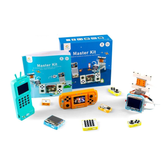-
500mm Chrome Plated Stainless Steel Smooth Rod 8mm diameter500mm Chrome Plated Stainless Steel Smooth Rod 8mm Diameter Generic High Precision Chrome Plated Smooth Rod is the perfect solution for your 3D printing and CNC needs. Measuring 500 MM in length and 8 MM in diameter, these rods offer precision, durability, and consistency...
- Rs. 283
Rs. 344- Rs. 283
- Unit price
- per
Save Rs. 61 -
380mm Stainless Steel Rod with 8mm Diameter380mm Stainless Steel Rod with 8mm Diameter The 380mm stainless steel rods are specifically designed for 3D printer kits. These 3D Printer Stainless Steel Rod are manufactured with stainless steel material and are given an extremely smooth finishing. Smooth stainless steel rods have a number of applications in...
- Rs. 227
Rs. 249- Rs. 227
- Unit price
- per
Save Rs. 22 -
300mm Stainless Steel Rod300mm Stainless Steel Rod with 8mm Diameter The 300mm stainless steel rods are specifically designed for 3D printer kits. They are manufactured with stainless steel material and are given an extremely smooth finishing. Smooth stainless steel rods have a number of applications in robotics and...
- Rs. 177
Rs. 199- Rs. 177
- Unit price
- per
Save Rs. 22 -
320mm Stainless Steel Rod with 8mm Diameter320mm Stainless Steel Rod with 8mm Diameter The 320mm stainless steel rods are specifically designed for 3D printer kits. These 3D Printer Stainless Steel Rod are manufactured with stainless steel material and are given an extremely smooth finishing. Smooth stainless steel rods have a number of applications in...
- Rs. 184
Rs. 249- Rs. 184
- Unit price
- per
Save Rs. 65 -
384mm Stainless Steel Rod with 8mm Diameter384mm Stainless Steel Rod with 8mm Diameter The 384mm stainless steel rods are specifically designed for 3D printer kits. They are manufactured with stainless steel material and are given an extremely smooth finishing. Smooth stainless steel rods have a number of applications in robotics and...
- Rs. 119
Rs. 181- Rs. 119
- Unit price
- per
Save Rs. 62 -
M8 400mm Stainless Steel RodM8 400mm Stainless Steel Rod The 400mm stainless steel rods are specifically designed for 3D printer kits. They are manufactured with stainless steel material and are given an extremely smooth finishing. Smooth stainless steel rods have a number of applications in robotics and 3D printing. In...
- Rs. 190
Rs. 329- Rs. 190
- Unit price
- per
Save Rs. 139
for additional 5% discount! + Redeem RC COINS 👇


























